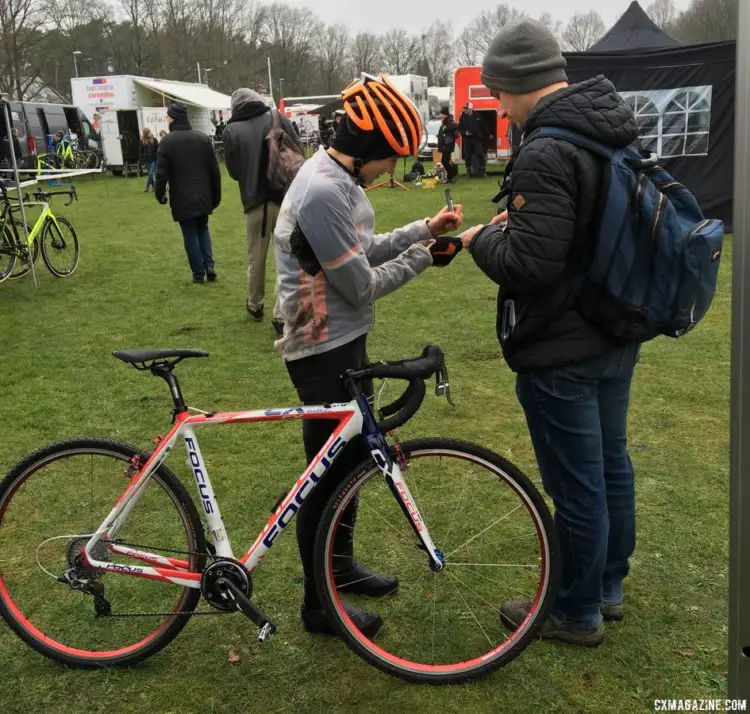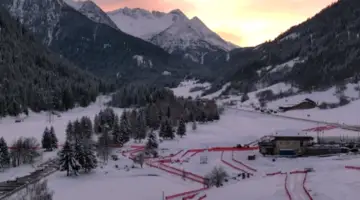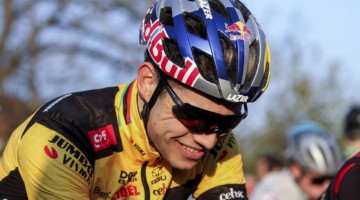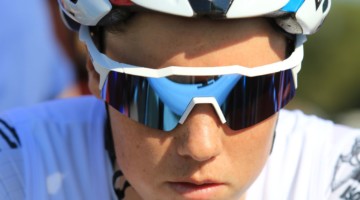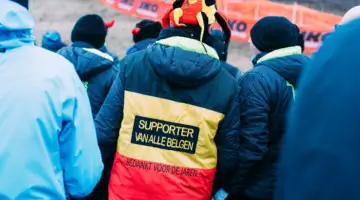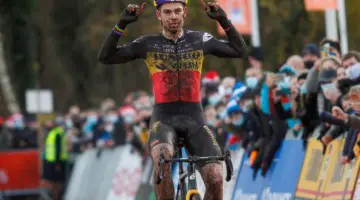Corey Coogan Cisek of Minnesota is living and racing in Belgium this winter. She will be providing regular diaries documenting her experiences of handing the Belgian winter, racing against the best and putting her year of Dutch studies to good use.
by Corey Coogan Cisek
In Belgium without a team, I am my own travel agent, director and soigneur. While so many of us manage a privateer program at home, doing so here takes considerably more planning. Good thing I am a Project Manager by trade!
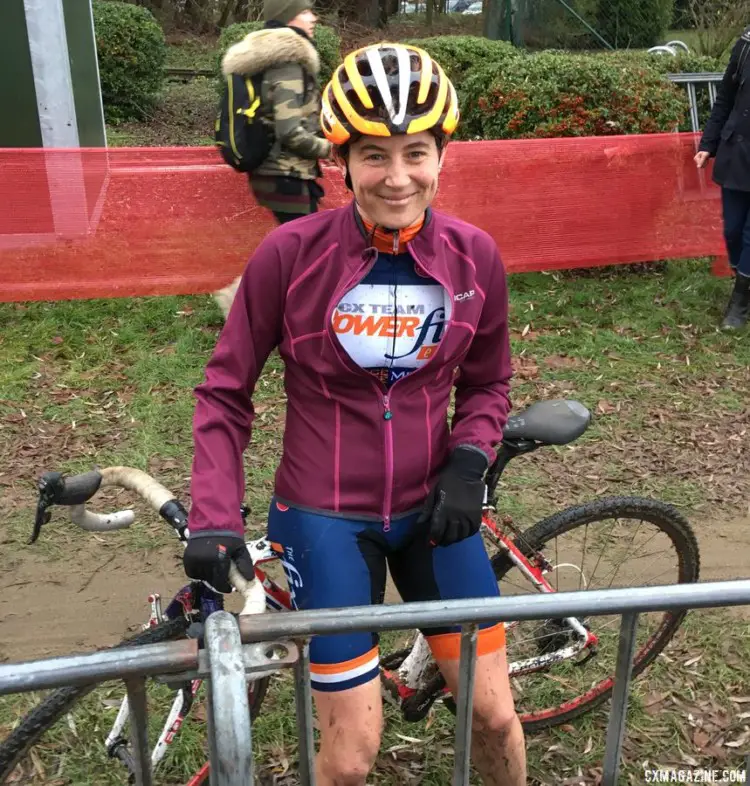
The author has been enjoying her stay in Belgium thus far. Corey Coogan Cisek rider diary. © S. De Poorte
Registering for a race in Belgium is a snap, once you figure out how to do it. Cycling Vlaanderen hosts a registration site that allows one to register for all their events, including every UCI C1 or C2 cyclocross race in Belgium. The site is even available in English, but where’s the fun in that? Once you complete your profile, it is simply a matter of selecting the races you want to do. I registered for my entire season in less than 15 minutes!
Of course, it’s faster to register when you don’t have to pay. That’s right, UCI races are free in Belgium. I know that surprises most Americans, but it makes sense. Here cyclocross is a spectator sport. Imagine charging NFL or MLB players to take the field, that would be … weird.
In Belgium, spectators pay 10 to 15 euros per person at the gate and then much more on bier, frites and frisdrank (soda), so the economic model is different.
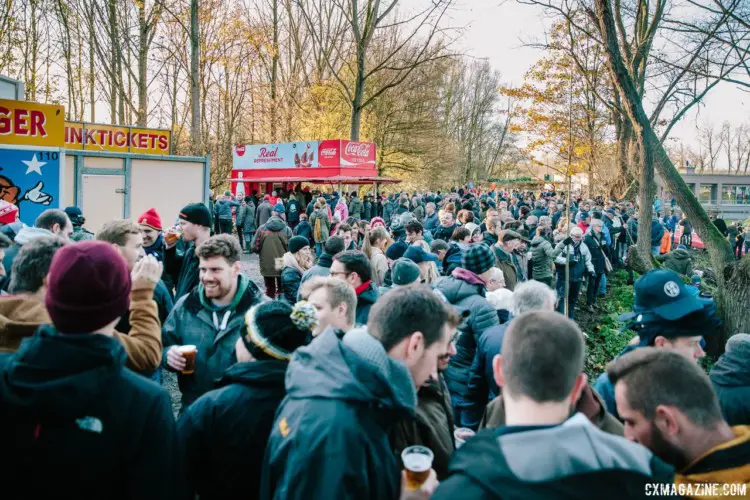
Spectators pay money to come drink beer, eat frites and watch bike racing, so the economic model in Belgium is a bit different than the U.S. 2017 Flandriencross. © J. Curtes / Cyclocross Magazine
I can’t tell you how much I enjoyed inputting a big zero in the entry fee column of my budget! Which brings me to another point: beyond the cost of your plane ticket and baggage fees, racing in Belgium is rather affordable. As long as one sticks to Belgium and the southern portion of the Netherlands, no race is more than two hours away. Thus the cost, and associated fatigue, of travel is minimal once you are here.
Race Day Logistical Adventures
While the distance to races is minimal, race day travel logistics never fail to be at least a little stressful. “Race day” for me begins several days earlier with a review of the race website. During my first trip to Belgium, this “study” took a long time and extensive use of Google Translate. Now, while my ability to speak Dutch remains minimal, I can usually comprehend race websites without translation. I make sure to record race times, the addresses for number pick-up and parking and get a general sense of the venue layout.
While in the States, I am okay with arriving at a UCI race three hours before race time. In Belgium, I arrive absurdly early, usually about four and a half hours before. Everything about racing in Belgium takes longer.
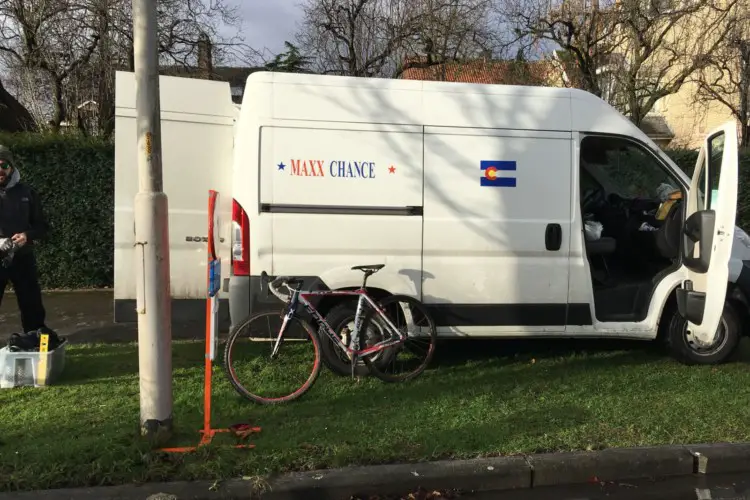
Corey Coogan Cisek’s race vehicle for her trip was once used by Maxx Chance. © C. Coogan Cisek / Cyclocross Magazine
Even the locals don’t drive without GPS in this country, so I can be forgiven for being dependent on mine to get to races. I usually input the address of number pickup, known as inschrijving, permanence or inscription, depending on the linguistic preference of the promoter.
Let op (pay attention), here comes an important tip! Before exiting the highway, I make sure to stop at one of the handy roadside “truck stops” in order to spend 50 Eurocent on a bathroom. When in Belgium, never pass up a bathroom.
While I keep the GPS running in case it happens to help, once I arrive at the race city, I look for the handy color-coded signage pointing to Inschrijving or parking for renners. Since parking for racers often requires a pass, I aim to hit number pick-up first. I typically become confounded at some point in the process and need to ask a parking marshall for directions.
A word about these volunteers: they are often older gentlemen and it’s not uncommon that they don’t speak English. In past trips, our conversations often consisted of my repeating “Inschrijving?” or “Engels?” and them giving directions with lots of hand gestures. Now, I am able to ask for, receive and clarify directions in Dutch.
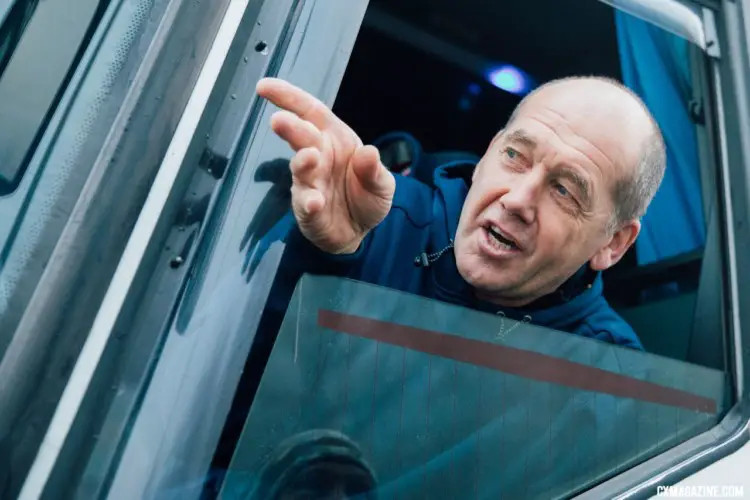
Getting directions to parking is always an adventure. Junior and U23 Men, 2017 Zeven UCI Cyclocross World Cup. © J.Curtes / Cyclocross Magazine
And then there is parking.
Parking at races ranges from a free-for-for all, where racers and support staff cram in every which way, often on the sidewalk, to a highly regimented assignment process where zones are cordoned off and teams are parked by social standing. In this case, the large teams receive prominent spots while juniors and their parents are relegated to streets, lots or farm fields further from the parcours (the course).
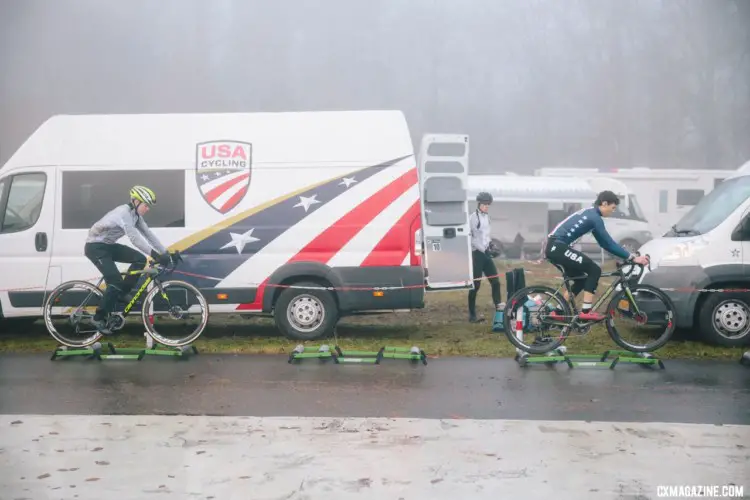
Parking is an unknown at pretty much every race. Junior and U23 Men, 2017 Zeven UCI Cyclocross World Cup. © J.Curtes / Cyclocross Magazine
Of the two, I much prefer the free-for-all, where the best parking goes to the savvy and creative. It’s simply too much to bear watching the parking guards puzzle over what to do with me, a single American of no import. My personal record for number pick-up and parking is around a half hour.
After picking up my number and finding parking, locating a bathroom is my next objective. In America, you can assume big banks of porta-potties, usually stocked with toilet paper (at least first thing in the morning), and often one or two at the start. Not to name names, but there was Overijse with only a few toilets on the parcours and one openbaar (public) toilet near renners parking. Essen had toilets everywhere, but precious few were stocked with paper first thing in the morning.
Extra credit goes to any athlete who readily finds the kleedkamers (showers). You know those showers that UCI promoters are required to provide? They really do provide them in Belgium, and in a land of cold and mud, they are the best!
Seeing the Future at a Local Race
Besides the UCI races I’ve been doing, I also attended one local, low-level race, as training and to experience the scene. This race took place at a cycling school in Ronse. Yes, that’s right, a cycling school is a school for preteens and teens where they study the ordinary academic subjects, train for cycling and study as mechanics.
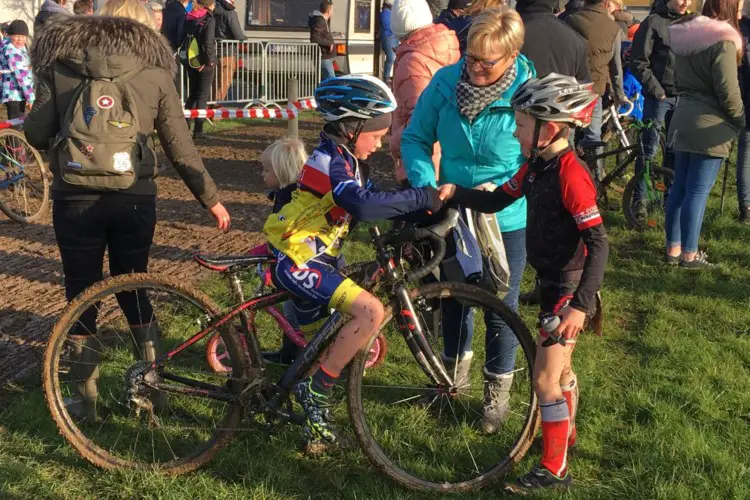
Belgian cycling schools start teaching young riders very early. Corey Coogan Cisek rider diary. © C. Coogan Cisek / Cyclocross Magazine
The race had two-year age classes for juniors, starting with 8 and under, who raced for 12 minutes.
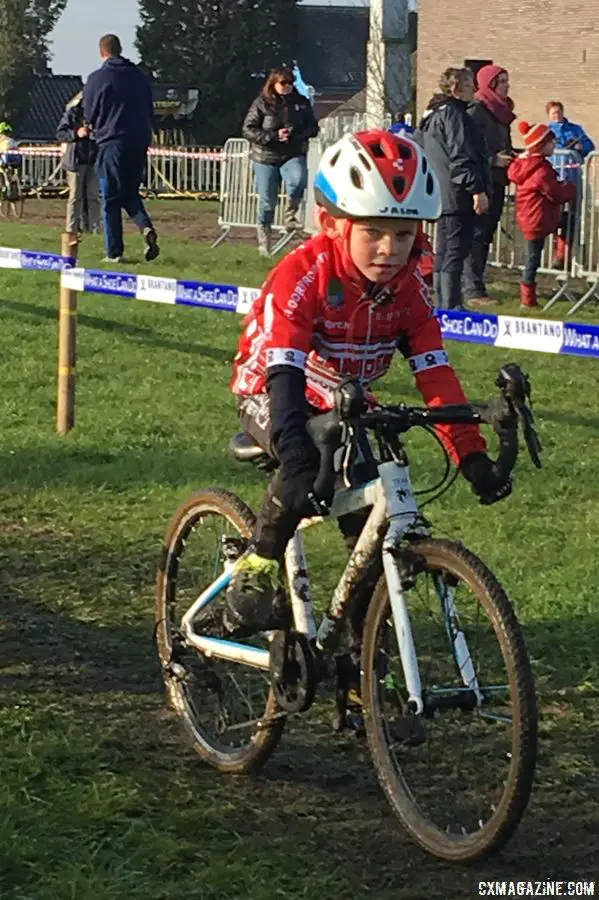
Children start riding at a young age in Belgium. Corey Coogan Cisek rider diary. © C. Coogan Cisek / Cyclocross Magazine
Two things were few and far between: mountain bikes and girls. Nearly every child has a true cyclocross bike, and girls are still the extreme minority — less than five percent by my estimation.
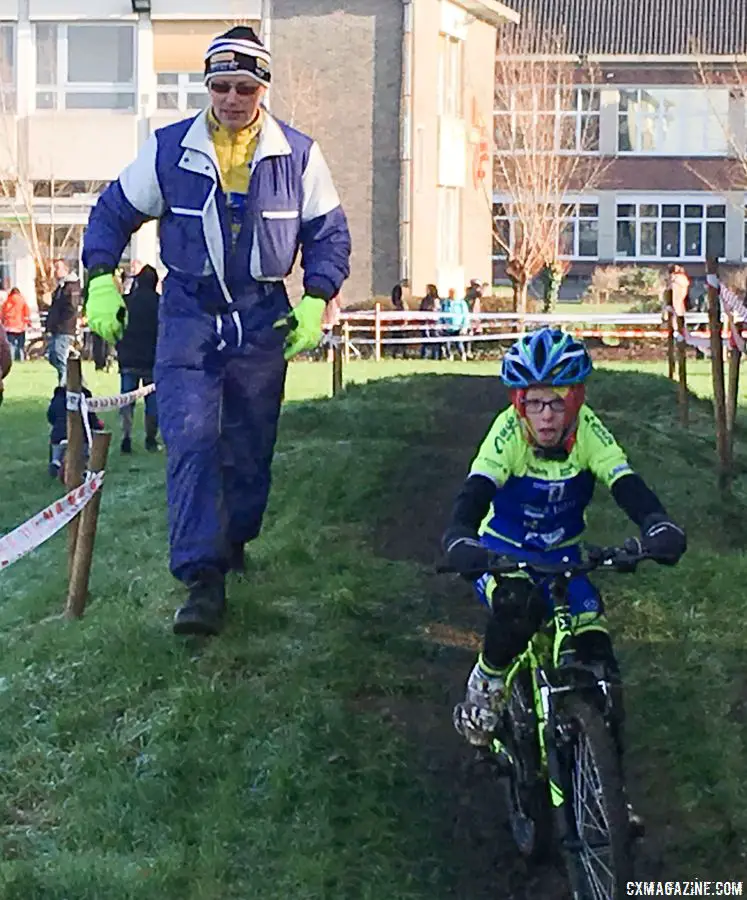
This lil’ ripper was one of the few young riders on a mountain bike. Most had cyclocross bikes. Corey Coogan Cisek rider diary. © C. Coogan Cisek / Cyclocross Magazine
The course in Ronse was easy, but when you realize how small the children were relative to the drops they rode down, it’s no wonder they develop tremendous bike handling skills.
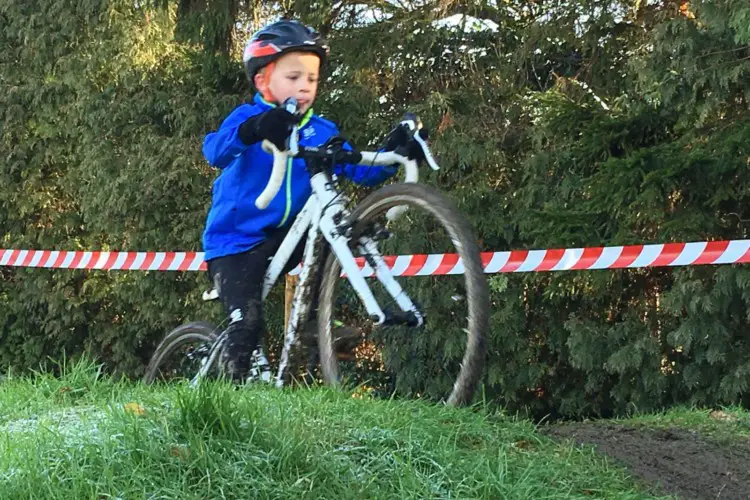
This young rider was working on his handling skills. Corey Coogan Cisek rider diary. © C. Coogan Cisek / Cyclocross Magazine
Rider Cards and Zolder
Just in time for Kerstperiode, my team of supporters over here upped our game by producing Corey Coogan Cisek rider cards. To me, cards seem excessive for a small fish like me, but people love to collect rider cards, so when in Rome …
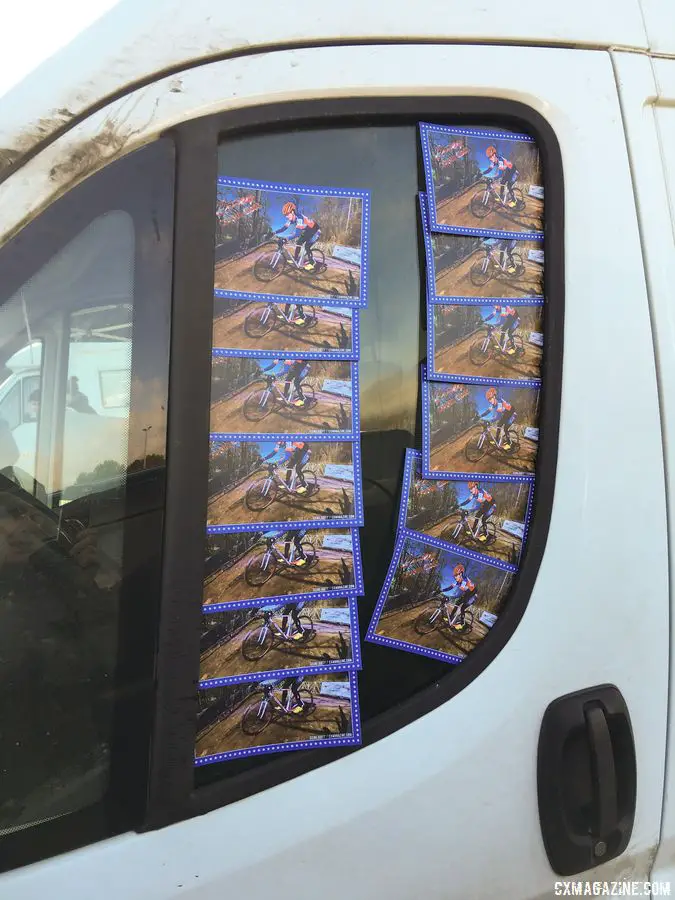
Riders get creative with their rider card distribution. Corey Coogan Cisek rider diary. © C. Coogan Cisek / Cyclocross Magazine
Each race produces a program with each and every rider listed. There are hobbyists who carry around their program and place a check near each name as they collect the rider’s card. On one hand, it’s fun, especially when kids are asking for your autograph. On the other hand, the novelty wears off quickly. It takes little time to identify the regulars, who seem ever-present, standing some distance off, staring.
And then there was Zolder! I was fortunate enough to get the 8th/last selection to the do the Zolder World Cup, and my husband and I were happy to revise our Christmas plans to attend. Even pre-riding the course was an experience! For an American in Belgium, pre-riding feels a bit like cramming for an exam. While not as technical as Namur, the steepness and sandiness of Zolder’s drops are beyond what we race in the US. Likewise, I’m still learning to ride a deep rut that loops a corner.
One thing is for sure: every day in this country makes me a better rider.
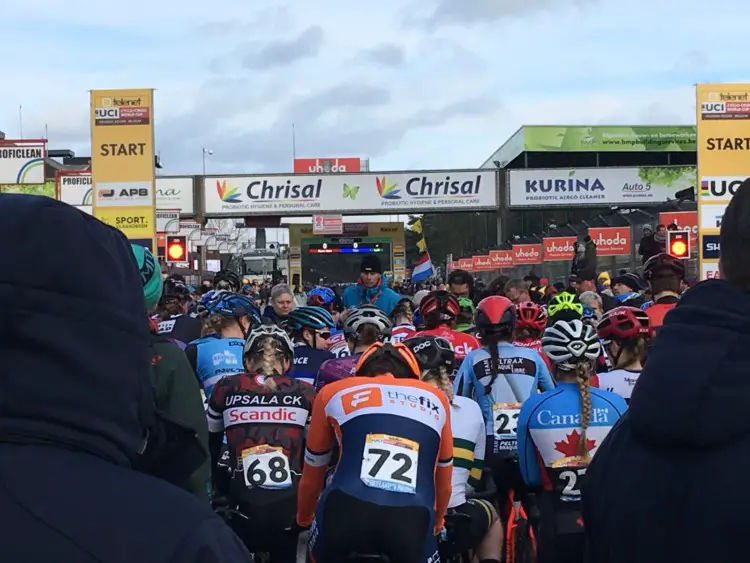
The author received a starting spot at the Zolder World Cup. Corey Coogan Cisek rider diary. photo: courtesy
How is a World Cup different from a C1? It’s just a little more: the course is a bit tougher, the crowds are bigger, the field is more international and larger and it’s faster.
Ever been in a crit that’s a bit over your head, and hear the official’s moto coming up behind you? That fear and the knowledge you must “go now” or else. Never before have I fought harder for a bottom of the pack placing. Everyone there is not only gifted and skilled, but also highly motivated because it is a “big day” for all. The experience was invaluable and no doubt something I will draw upon one day when coaching Juniors at big competitions.
Now it’s on to more Kerstperiode racing and trying to improve my number pick-up to parking time. If only there were Strava QOMs for the feat.













